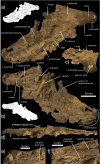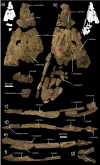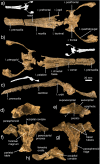High morphological disparity in a bizarre Paleocene fauna of predatory freshwater reptiles
- PMID: 35313822
- PMCID: PMC8935759
- DOI: 10.1186/s12862-022-01985-z
High morphological disparity in a bizarre Paleocene fauna of predatory freshwater reptiles
Erratum in
-
Correction: High morphological disparity in a bizarre Paleocene fauna of predatory freshwater reptiles.BMC Ecol Evol. 2022 Apr 15;22(1):49. doi: 10.1186/s12862-022-02000-1. BMC Ecol Evol. 2022. PMID: 35428197 Free PMC article. No abstract available.
Abstract
Background: The consequences of the K-Pg mass extinction are reflected across present biodiversity, but many faunas that appeared immediately after the extinction event were very different from current ones. Choristodera is a clade of reptiles of uncertain phylogenetic placement that have an extremely poor fossil record throughout their 150-million-year history. Yet, choristoderes survived the K-Pg event and persisted until the Miocene.
Results: I describe the skulls and skeletons of two new choristoderes from a single Paleocene ecosystem in western North America that reveal the hidden Cenozoic diversity of this reptile clade. Despite their similar size, the new species deviate dramatically in morphology. Kosmodraco magnicornis gen. et sp. nov. possesses an extremely short snout and extensive cranial ornamentation. The sacrum of K. magnicornis bears enlarged muscle attachment sites and other modifications reminiscent of some giant crocodylians. In contrast, Champsosaurus norelli sp. nov. is a longirostrine species with an uninflated and ventrally divergent postorbital skull. Together with a North American choristodere previously classified in the European genus Simoedosaurus, K. magnicornis substantiates a new clade of giant, short-snouted taxa endemic to the Americas. C. norelli is found to be an early-diverging member of the genus Champsosaurus from the Cretaceous-Paleogene of the northern hemisphere. This suggests the presence of several ghost lineages of champsosaurid that crossed the K-Pg boundary.
Conclusions: The new taxa greatly increase Cenozoic choristodere richness and strengthen the evidence for the existence of distinctive freshwater faunas in Paleogene Eurasia and North America, where this clade diversified to exploit newly available macropredatory niches in the aftermath of the asteroid impact. The new choristoderes also reveal the distinct ecological context in which extant freshwater predators of the Americas like alligatoroids and gars have their origins: Paleocene fluviolacustrine ecosystems in North America displayed high large predator diversity and morphological disparity relative to modern ones.
Keywords: Biogeography; Cenozoic; Choristodera; Ecosystem recovery; K-Pg; Phylogenetics.
© 2022. The Author(s).
Conflict of interest statement
The authors declare no competing interests.
Figures














Similar articles
-
Hydroids (Cnidaria, Hydrozoa) from Mauritanian Coral Mounds.Zootaxa. 2020 Nov 16;4878(3):zootaxa.4878.3.2. doi: 10.11646/zootaxa.4878.3.2. Zootaxa. 2020. PMID: 33311142
-
Miocene fossils from the southeastern Pacific shed light on the last radiation of marine crocodylians.Proc Biol Sci. 2022 May 11;289(1974):20220380. doi: 10.1098/rspb.2022.0380. Epub 2022 May 11. Proc Biol Sci. 2022. PMID: 35538785 Free PMC article.
-
An armoured marine reptile from the Early Triassic of South China and its phylogenetic and evolutionary implications.Elife. 2023 Aug 8;12:e83163. doi: 10.7554/eLife.83163. Elife. 2023. PMID: 37551884 Free PMC article.
-
High diversity, low disparity and small body size in plesiosaurs (Reptilia, Sauropterygia) from the Triassic-Jurassic boundary.PLoS One. 2012;7(3):e31838. doi: 10.1371/journal.pone.0031838. Epub 2012 Mar 16. PLoS One. 2012. PMID: 22438869 Free PMC article. Review.
-
Bird evolution in the Eocene: climate change in Europe and a Danish fossil fauna.Biol Rev Camb Philos Soc. 2006 Nov;81(4):483-99. doi: 10.1017/S146479310600707X. Epub 2006 Aug 8. Biol Rev Camb Philos Soc. 2006. PMID: 16893476 Review.
Cited by
-
Correction: High morphological disparity in a bizarre Paleocene fauna of predatory freshwater reptiles.BMC Ecol Evol. 2022 Apr 15;22(1):49. doi: 10.1186/s12862-022-02000-1. BMC Ecol Evol. 2022. PMID: 35428197 Free PMC article. No abstract available.
References
-
- Bartels WS. A transitional Paleocene-Eocene reptile fauna from the Bighorn Basin, Wyoming. Herpetologica. 1983; 359–374.
-
- Bemis WE, Findeis EK, Grande L. An overview of Acipenseriformes. Environ Biol Fishes. 1997;48(1):25–71.
-
- Böhmer C, Rauhut OWM, Wörheide G. New insights into the vertebral Hox code of archosaurs. Evol Dev. 2015;17(5):258–269. - PubMed
MeSH terms
LinkOut - more resources
Full Text Sources
